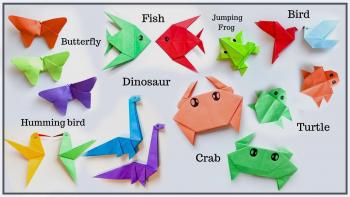
The art of paper folding! Origami is a Japanese word, and most people think of origami as a Japanese art form, but people have been creating works of art by folding paper for so long that much of the history has been forgotten or lost. It is uncertain whether it began in Japan or China. Paper was invented in China in 105 A.D. but did not make its way to Japan until 610. Ever since the invention of paper, people have been folding it in various ways to make beautiful works of art. And now, there are origami enthusiasts and organizations all over the world!


- In Japan, school children fold thousands of cranes. Cranes symbolize happiness, peace, longevity, and good health. Folding the cranes demonstrates the power of unity and their hope for world peace.
- The Japanese word "origami" comes from two smaller Japanese words. Ori, which means to fold, and kami, which means paper.
- The first Japanese origami was used for religious ceremonial purposes only, due to the high price of paper.
- Origami butterflies are used during Shinto weddings to represent the bride and groom.
- Samurai warriors are known to have exchanged gifts adorned with noshi, a sort of good luck token made of folded strips of paper.
- Origami paper is white on one side and colored on the other. But the great thing about origami is that you can use any paper you want. Even scrap paper, or notebook paper. Something that works really well is ordinary wrapping paper! You just need to cut it into a square.
Easy Origami by Didier Boursin
Origami for Fun! by Thiranut Deborah Berry
Origami: Classic Paper Folding by Rachael L. Thomas
Lissy’s Friends by Grace Lin
Butterflies for Kiri by Cathryn Falwell
The Strange Case of Origami Yoda by Tom Angleberger
Darth Paper Strikes Back: An Origami Yoda Book by Tom Angleberger
